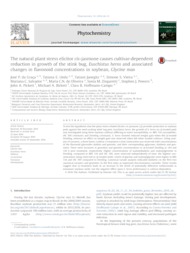The natural plant stress elicitor cis-jasmone causes cultivar-dependent reduction in growth of the stink bug, Euschistus heros and associated changes in flavonoid concentrations in soybean, Glycine max.
The natural plant stress elicitor cis-jasmone causes cultivar-dependent reduction in growth of the stink bug, Euschistus heros and associated changes in flavonoid concentrations in soybean, Glycine max.
Author(s): GRAÇA, J. P da; UEDA, T. E.; JANEGITZ, T.; VIEIRA, S. S.; SALVADOR, M. C.; OLIVEIRA, M. C. N. de; ZINGARETTI, S. M.; POWERSH, S. J.; PICKETT, J. A.; BIRKETT, M. A.; HOFFMANN-CAMPO, C. B.
Summary: To test the hypothesis that the plant stress related elicitor cis-jasmone (cJ) provides protection in soybean pods against the seed-sucking stink bug pest, Euschistus heros, the growth of E. heros on cJ-treated pods was investigated using three soybean cultivars differing in insect susceptibility, i.e. BRS 134 (susceptible), IAC 100 (resistant) and Dowling (resistant). E. heros showed reduced weight gain when fed cJ-treated Dowling, whereas no effect on weight gain was observed when fed other treated cultivars. Using analysis of variance, a three factor (cultivar x treatment x time) interaction was observed with concentrations of the flavonoid glycosides daidzin and genistin, and their corresponding aglycones, daidzein and genistein. There were increases in genistein and genistin concentrations in cJ-treated Dowling at 144 and 120 h post treatment, respectively. Higher concentrations of malonyldaidzin and malonylgenistin in Dowling, compared to BRS 134 and IAC 100, were observed independently of time, the highest concentrations being observed in cJ-treated seeds. Levels of glycitin and malonylglycitin were higher in BRS 134 and IAC 100 compared to Dowling. Canonical variate analysis indicated daidzein (in the first two canonical variates) and genistein (in the first only) as important discriminatory variables. These results suggest that cJ treatment leads to an increase in the levels of potentially defensive isoflavonoids in immature soybean seeds, but the negative effect upon E. heros performance is cultivar-dependent.
Publication year: 2016
Types of publication: Journal article
Unit: Embrapa Soybean
Keywords: Entomologia, Percevejo, Soja
Observation
Some of Embrapa's publications are published as ePub files. To read them, use or download one of the following free software options to your computer or mobile device. Android: Google Play Books; IOS: iBooks; Windows and Linux: Calibre.
Access other publications
Access the Agricultural Research Database (BDPA) to consult Embrapa's full library collection and records.
Visit Embrapa Bookstore to purchase books and other publications sold by Embrapa.

